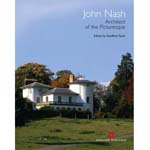Book Review: John Nash: Architect of the Picturesque
Book Review: John Nash: Architect of the Picturesque


To order any of the books reviewed or any other book in print, at
discount prices* and with free p&p to UK addresses, telephone the
Country Life Bookshop on Bookshop 0843 060 0023. Or send a cheque/postal
order to the Country Life Bookshop, PO Box 60, Helston TR13 0TP.
Alternatively visit www.countrylife.co.uk/bookshop.
Architecture John Nash: Architect of the Picturesque Edited by Geoffrey Tyack (English Heritage, £60, *£54)
Earlier this spring, through the particular labours of the editor of this book, a Blue Plaque was unveiled to one of most celebrated architects of the Regency, John Nash (1752-1835). This book is a fulsome explanation of why Nash deserves such a memorial: the spectrum of his work is extraordinary, from Gothic castles to Italianate villas, from Brighton Pavilion to Buckingham Palace, and from the shopping mall of Regent's Street to the rus in urb of Regent's Park. And so much of it confounds expectation in terms of detailing, massing and setting. No wonder one 1950s scholar, confronted with the task of cataloguing Nash's architecture, considered such unorthodox headings as ‘Bizarre', ‘Scholarly', ‘Gloomy' and ‘Inventive'.
Sign up for the Country Life Newsletter
Exquisite houses, the beauty of Nature, and how to get the most from your life, straight to your inbox.
Yet for all the variety, ambition and bravura that characterises so much of Nash's work, his plaque hangs on a relatively unremarkable stuccoed terrace opposite the British Museum. This building, erected in 1777-78, was part of Nash's first major London development and was briefly his home. Such might have been his output, but for his bankruptcy in 1783. With financial difficulties compounded by the scandal of a divorce, Nash was forced that year to leave the capital and remove to Carmarthen.
Curiously, this ignominious departure was to lay the foundation of his future career. Rebuilding his reputation through solid county work, including prisons, bridges and rural villas, he was introduced to three of the leading advocates of the Picturesque movement: Uvedale Price, Richard Payne Knight and Humphry Repton. These connections were to help transform his practice.
* Subscribe to Country Life and save; Get the Ipad edition
Nash re-established himself as a cosmopolitan architect-returning to London in 1797-and entered into a brilliantly successful career. By his 60th birthday in 1812, he was also beginning to enjoy the fruits of government employment and his first project for the Prince Regent, a cottage ornée in Windsor Great Park, followed a year later. Government employment gave Nash his greatest opportunities, but the close of his career was overshadowed by financial difficulties and his dismissal from official employment in 1831.
One of the great achievements of this book is to give a coherent account of Nash's complex life and career through a series of nine independently written essays. The first of these, by Richard Suggett, looks at Nash's early life and the collapse of his business, which drove him into provincial practice. David Whitehead then tells how he rebuilt his career in Herefordshire during the 1790s.
The next five essays (by Geoffrey Tyack, twice, Rosemary Yallop, J. Mordaunt Crook and M. H. Port) look at different strands of Nash's work-respectively, his Gothic houses, his Italianate villas, the genesis of Regent's Park, the redevelopment of the West End and the palaces built for George IV as Prince Regent and King.
Finally, Jonathan Clarke considers Nash as a structural innovator and David Watkin dis-cusses the response of European contemporaries to his work. The volume is well illustrated throughout, but the section on the West End is particularly well treated and includes numerous early photographs with discursive captions. Underpinned with a great deal of new research, this book offers a refreshing reappraisal of Nash and authoritatively sets out his impressive architectural achievement.
* Follow Country Life magazine on Twitter
Country Life is unlike any other magazine: the only glossy weekly on the newsstand and the only magazine that has been guest-edited by HRH The King not once, but twice. It is a celebration of modern rural life and all its diverse joys and pleasures — that was first published in Queen Victoria's Diamond Jubilee year. Our eclectic mixture of witty and informative content — from the most up-to-date property news and commentary and a coveted glimpse inside some of the UK's best houses and gardens, to gardening, the arts and interior design, written by experts in their field — still cannot be found in print or online, anywhere else.
-
 380 acres and 90 bedrooms on the £25m private island being sold by one of Britain's top music producers
380 acres and 90 bedrooms on the £25m private island being sold by one of Britain's top music producersStormzy, Rihanna and the Rolling Stones are just a part of the story at Osea Island, a dot on the map in the seas off Essex.
By Lotte Brundle
-
 'A delicious chance to step back in time and bask in the best of Britain': An insider's guide to The Season
'A delicious chance to step back in time and bask in the best of Britain': An insider's guide to The SeasonHere's how to navigate this summer's top events in style, from those who know best.
By Madeleine Silver